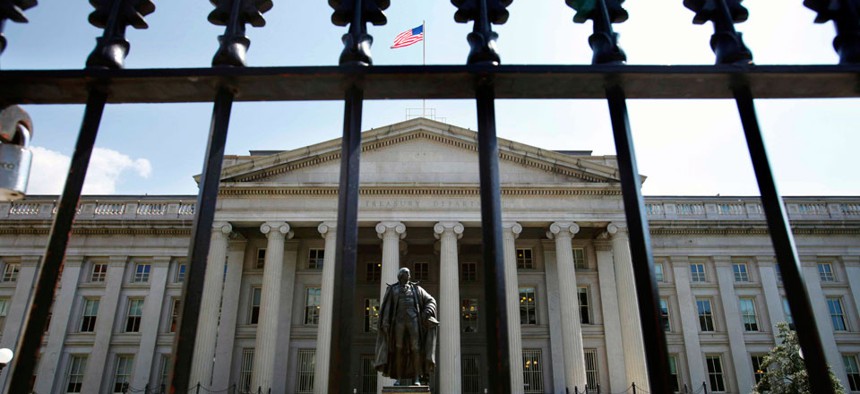
The Treasury Department building in Washington Jacquelyn Martin/AP File Photo
The Deadly Dates of a Debt-Ceiling Standoff
Here are a few of the most likely dates for a default.
Nobody in the White House, nobody in Congress, and nobody anywhere else knows the exact date the government will begin defaulting on its debts.
Treasury Secretary Jacob Lew has handed Congress an Oct. 17 deadline for raising the debt limit, but he's only giving them his best guess.
The lack of a final deadline could be a problem for Congress, which is in the process of crafting a last-minute budget deal to stave off a government shutdown.
But the debt ceiling's timing doesn't work like a government shutdown, where all parties involved know months ahead exactly when the current budget will expire. Instead, default happens whenever the Treasury doesn't have the money on hand to pay its incoming bills.
The rate at which those bills arrive, however, is variable. There are a few dates in the weeks to come where the invoices will be particularly large, the finances will be particularly tight, and the danger of default will run the highest.
Here are the dates that have analysts at the Bipartisan Policy Center especially anxious:
Oct. 17-18—The "X Date": Lew picked midnight on October 17 for a debt-ceiling deadline, and the BPC analysts agree, having set an "X Date" that starts the first minute of October 18. From that moment on, the center says, the government is at real risk of default at any time, because it will be out of borrowing room and will be wagering that its unpredictable revenue streams will be enough to cover the incoming bills.
Oct. 23—Social Security's First Hiccup: The federal government owes the nation's seniors $12 billion in Social Security payments. There are bigger payments to come, but imagine for a moment the political fallout of Washington failing to deliver even a tiny fraction of what it owes to the elderly. That's the sort of move that gets incumbents tossed out of office, as well as triggering an all-out messaging blitz to pin the blame on the other party.
November 1—Day of the Debt-Ceiling Dead: It all comes to a head at the start of November, when Treasury will be hit with, at least, a combined $58 billion worth of bills. That includes $18 billion in Medicare payments, another $25 billion for Social Security, and $12 billion in payments to active military and veterans. Toss on top of that a $6 billion interest payment on the public debt that comes due Oct. 31, and the BPC analysts see default as near-certain without a raise in the debt ceiling.
"I think it's exceedingly unlikely they can make it past Halloween," said Steve Bell, a former top GOP staffer and the director of BPC's economic-policy project. "The Lord indeed has a great sense of humor."
Read more about BPC's debt ceiling calendar here.
NEXT STORY: On Shutdown Day, Employees Must Still Show Up






